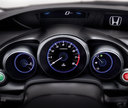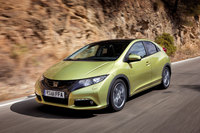First Drive: 2012 Honda Civic (European Version) by Henny Hemmes +VIDEO
By Henny Hemmes
Senior European Editor
The Auto Channel
ESTEPONA, December 12, 2011: When figuring out what to change and what to keep for the 9th generation of the Civic, Honda talked to many customers and to people who did not buy the current model. The conclusion was no surprise: the new Civic would have the good features of its predecessor and the not-so-good ones were going to be changed.
In other words, the design of the new generation has been slightly worked over, but the technical changes are considerable.
 |
 |
What I do know is that Honda had two or three of their former Formula One engineers working on the body. The new Civic ended up with a Cd of 0.27, thanks to the low slung front. But what we do not realize, according to Christoph Rust, spokesperson for Honda Europe, is that the rear bumper has a huge influence (70%) on the total aerodynamics of a car and in this case was not only important for meeting the crash regulations, but also for the aerodynamics. Rust: “The form follows function approached was turned into form follows philosophy.”
Better view
 |
 |
Since the lay out of the platform has not been changed, the fuel tank is again placed under the front seats to accommodate a low floor and thus installing the ‘Magic Seats’. Those are the rear seats that e split 60/40 and fold down on the floor by just one move. That way, in combination with the luggage compartment, a flat floor is created, generating 1,378 liters of content (48.6 cu.ft), while its standard content of 477 l (16.8 cu.ft) is the largest in its segment. During the introduction of the current Civic, Honda proved that a mountain bike fits into the Civic without great effort.
 |
 |
Watch the Honda Civic introduction at the 2011 Frankfurt Motor Show
More all-round
 |
With its 1.8-liter gasoline engine it is happy to hit winding roads, but going uphill in the mountains in the south of Spain is costing somewhat more of an effort. In this respect the 2.2-liter diesel engine with a considerable higher torque is better suited to do the work.
The 1.8i VTEC engine has 142 hp and 174 Nm (128 lb-ft) of torque, while the 2.2i DTEC diesel engine has 150 hp and 350 Nm (253 lb-ft) maximum torque.
The six-speed transmission shifts quickly and effortless, while an automatic transmission is available for combination with the 1.8 engine only. There also is the 100 hp strong (127 Nm/94 lb-ft) 1.4i VTEC engine that will suit many drivers’ needs, especially in a flat country like The Netherlands.
Fuel saving
Honda’s goal was to reduce fuel consumption of all three engines and succeeded so. Because of reducing engine friction and optimizing combustion, the 1.4 and 1.8 engines sip 10 percent less gas, while the 2.2 diesel motor, with 10 hp more, uses 20 percent less fuel. To meet certain CO2-emission regulations in Europe and stay under 110 g/km, Honda had to equip the diesel model with a little side spoiler and an air shutter in the grille. The Eco-assist button debuts in a non-hybrid Honda and is meant to encourage drivers to think about the weight of their right foot.
Even though these engines are all new, the Japanese are actually in the final stages of development of a complete new engine family with innovative technology. The first variant to hit the market will be the 1.6-liter diesel power plant, that is due for introduction in February 2013. Later, the 1.4 and 1.8 variants will be replaced.
The 9th generation will hit European markets in February and will be only available in a five-door configuration. The rear doors are somewhat hidden by the ‘invisible’ door grips. Next to being a more all-round model, the new Civic also offers LED day tiem running lights, a capless fuelling system, ACC Adaptive Cruise Control, speed limiter, and – for the first time in the Civic - CMBS Collision Mitigation Brake System (depending on the model line). Prices are competitive with for example a Dutch base price for the 1.4i VTEC of E 18.990, including a lot of tax…



